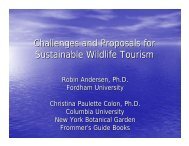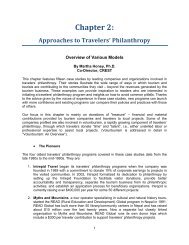Chapter 7: Conclusion - Center for Responsible Travel
Chapter 7: Conclusion - Center for Responsible Travel
Chapter 7: Conclusion - Center for Responsible Travel
Create successful ePaper yourself
Turn your PDF publications into a flip-book with our unique Google optimized e-Paper software.
embolden the concept so that it becomes an effective tool <strong>for</strong> social empowerment andsustainable development. One of the most important developments has been the growingrecognition that travelers‘ philanthropy should not be based on a top down or charity model inwhich the traveler or tourism company decides what and when to give. Rather, to be effective, itmust be a needs-based model with the local community or organization ―taking ownership‖ ofthe giving process, setting the priorities and selecting the projects to be supported. <strong>Travel</strong>companies play a role, of course, but community organizations need to be the primary drivers inany philanthropy-based development initiatives.Another development is to move, in some locations, from the model of individual tourismbusinesses establishing their own travelers‘ philanthropy programs to tourism businesses withina location collectively a building destination-wide travelers‘ philanthropy fund. All travelbusinesses who are part of the fund then promote and help raise contributions <strong>for</strong> the samesuite of projects. This model is probably best suitable <strong>for</strong> destinations with active and engagedlocal communities and a clear, positive image in the tourism market. The organization IGTOAwas one of the first to adopt this approach, organizing under a single umbrella many of the touroperators in the Galapagos. Today the concept of creating a destination-wide fund is beingpiloted in both Monteverde and the Osa Peninsula in Costa Rica, and is being consideredelsewhere.Finally, Lars Lindkvist provides seven key words and their underlying concepts that can beused, as he writes, ―to give ourselves some preferred direction as to where we are heading withtravelers‘ philanthropy.‖ They are:1. Complexity: Recognize Complexity be<strong>for</strong>e Generality.2. Partnership: Aim <strong>for</strong> Partnership be<strong>for</strong>e Individual.3. Investment: Consider Investment be<strong>for</strong>e Charity.4. Sustainable Change: Prepare <strong>for</strong> Sustainable Change be<strong>for</strong>e Status Quo.5. Proactive: Be Proactive be<strong>for</strong>e Reactive.6. Long Term: Think Long-term be<strong>for</strong>e Event.7. Professional: Balance Professional against Interest.Lars‘ concludes his essay – and we conclude this Handbook – with the hope that these keywords become more than simply buzz words. Rather, when put together they can provide someguidance <strong>for</strong> the future of travelers‘ philanthropy:“We travel in recognition of the complexity in the societies and environments we visit and seekto locally support sustainable change by proactive investments in long-term professionalpartnership projects.”10















